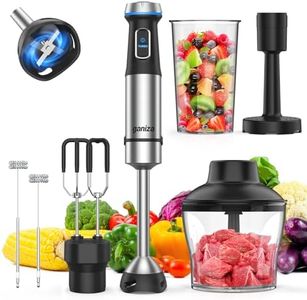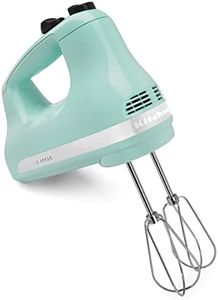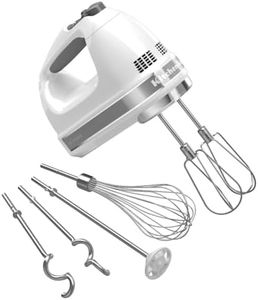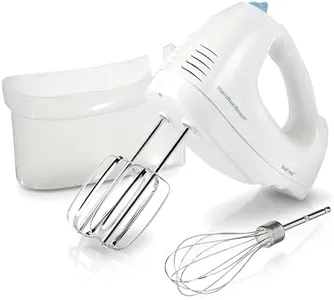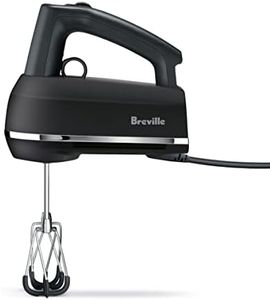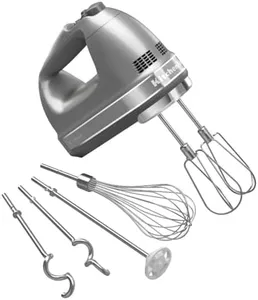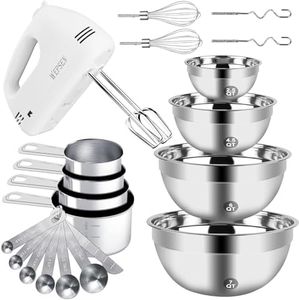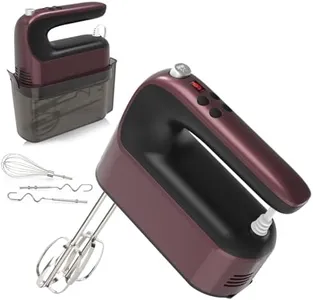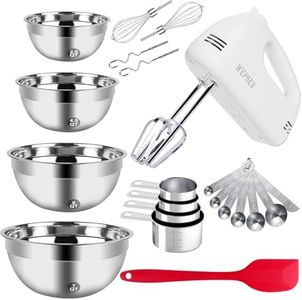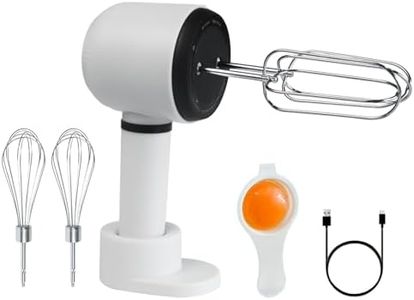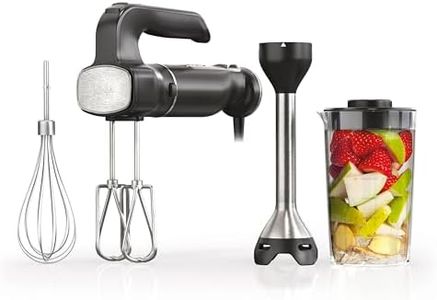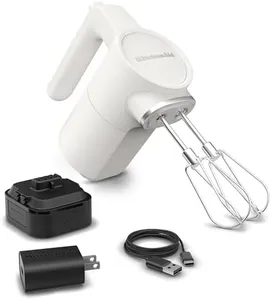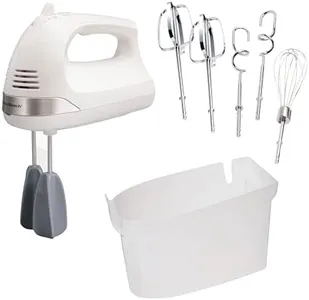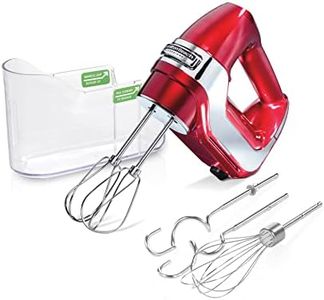10 Best Hand Mixers 2025 in the United States
Our technology thoroughly searches through the online shopping world, reviewing hundreds of sites. We then process and analyze this information, updating in real-time to bring you the latest top-rated products. This way, you always get the best and most current options available.

Our Top Picks
Winner
KitchenAid 5 Ultra Power Speed Hand Mixer - KHM512, Ice Blue
Most important from
26188 reviews
The KitchenAid 5 Ultra Power Speed Hand Mixer is a solid choice if you want a reliable, easy-to-use mixer for everyday baking tasks. With five speed settings, it lets you handle everything from gently mixing in nuts to whipping up fluffy meringues, giving you good control over the mixing process. The included Stainless Steel Turbo Beater is designed to mix ingredients thoroughly, and having dishwasher-safe attachments makes cleanup quick and simple, which is a big plus for convenience.
Weighing about 2 pounds, it’s light enough to hold comfortably for most users, and the lockable swivel cord helps keep things neat and out of the way while you work. The build quality reflects KitchenAid’s reputation as a trusted brand, offering durability that should last through many baking sessions. Although this mixer has been available since 2014 and may lack some newer features such as additional speed options or specialized beaters, it remains a durable and well-made tool.
Its compact size makes it best suited for home bakers rather than heavy-duty or commercial use. If you want a straightforward, durable hand mixer that covers all the basic needs with ease and reliability, this model fits well, especially if you appreciate the brand’s proven quality.
Most important from
26188 reviews
KitchenAid 9-Speed Hand Mixer - KHM926, White
Most important from
8089 reviews
The KitchenAid 9-Speed Hand Mixer is a versatile and well-built tool designed to handle a variety of kitchen mixing tasks. With nine different speed settings, it offers plenty of control, from slow stirring to fast whipping, making it suitable for everything from mixing in nuts to kneading dough. It comes with a wide range of attachments including turbo beaters for heavy ingredients, a whisk for light mixtures, dough hooks for bread dough, and a blending rod for smoothies or dressings, which adds great flexibility for home cooks.
Weighing about 2.3 pounds, it strikes a good balance between being sturdy yet comfortable to hold for most users. The build quality is solid, reflecting KitchenAid's reputation as a leading brand, and the detachable parts are dishwasher-safe, making cleanup straightforward. While it may not be the lightest mixer on the market, its performance and range of accessories justify the weight for those who bake or cook regularly.
If you want a reliable hand mixer that can handle both simple and more demanding tasks with ease, this model is a smart choice.
Most important from
8089 reviews
Hamilton Beach 6-Speed Electric Hand Mixer with Whisk, Traditional Beaters, Snap-On Storage Case, 250 Watts, White
Most important from
64449 reviews
The Hamilton Beach 6-Speed Electric Hand Mixer stands out for its user-friendly design and powerful performance. With a peak power of 250 watts, it efficiently mixes a variety of ingredients, making it suitable for both novice bakers and experienced cooks. The six-speed settings, along with a QuickBurst button, allow for precise control while mixing, whether you're blending cake batter or whipping cream.
One of the most convenient features is the snap-on storage case, which keeps the two traditional beaters and whisk organized and prevents them from getting lost. This thoughtful design adds to its practicality, especially for those with limited kitchen space. The Bowl Rest feature is also a nice touch; it stabilizes the mixer on the edge of a bowl, which helps minimize mess and keeps your workspace tidy.
However, there are a few areas where this mixer may fall short. While the plastic build keeps the product lightweight at just 1.3 kilograms, it could raise concerns regarding durability over time. Users looking for a more robust appliance might prefer options made with higher-quality materials. Additionally, although the attachments are dishwasher safe, the plastic controls might not offer the same longevity as metal alternatives. Lastly, while the mixer is generally easy to clean, some users might find that the plastic surface can be prone to scratches or wear, especially if not handled carefully. This hand mixer is a solid choice for everyday use, particularly for those who value convenience and ease of storage, but it may not satisfy the demands of those seeking a heavy-duty kitchen tool.
Most important from
64449 reviews
Buying Guide for the Best Hand Mixers
Choosing the right hand mixer can make a big difference in your kitchen, whether you're a casual baker or a cooking enthusiast. Hand mixers are versatile tools that can help you with a variety of tasks, from whipping cream to mixing dough. To find the best hand mixer for your needs, it's important to consider several key specifications. Understanding these specs will help you make an informed decision and ensure that you get a product that fits your cooking style and requirements.FAQ
Most Popular Categories Right Now
